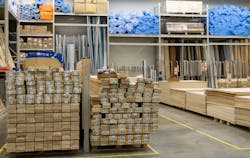Even When Adjusted for Inflation, Lumber Prices Set Record Highs in 2020 and 2021
Lumber prices began soaring at the start of the COVID-19 pandemic in early 2020, increasing by a staggering 175% from April to September before hitting a peak price of $1,500 per thousand board feet in May 2021, roughly three times the all-time high pre-pandemic. Even when adjusting for inflation, lumber prices smashed decades-old records in both 2020 and 2021.
Over a 24-month span from 2020 to 2021, real prices were 37% higher than the historical average. Unfortunately for builders, costs will likely remain elevated months into 2022, especially as low sawmill output and an unpredictable supply chain keep supply limited amid rising demand.
The Random Lengths Framing Lumber Composite Price has more than tripled since late August 2021 and front-month lumber futures have roughly doubled. Although mill prices have eased slightly in the past couple of weeks, it will take a sustained downward trend for the typical builder to get any relief. Due to the mechanics of the lumber supply chain, builders and homeowners are unfortunately the last to see their costs go down.
Unfortunately, increases in output of the U.S. softwood lumber industry over the past 18 months have been negligible even as housing starts have soared. As housing demand remains strong, the only structural means by which another dubious price record is avoided is increased sawmill output.
